Engagement Ring - In Progress
Setting
Stone
We guarantee that every single purchase directly impacts one person's life by giving them access to clean water.
Sapphire is a rare, beautiful, and mega durable gemstone that comes in a variety of colors. It is a 9 on the Mohs hardness scale, making it the hardest colored gemstone out there for daily wear. And, it’s great for engagement rings! This gem comes in all the colors of the rainbow, except red, which is its cousin, ruby. Sapphire and Ruby are both part of the corundum family.
Gem Geek Moment: Diamond is pure carbon; sapphire is an aluminum oxide!

Elsa in sapphire vs diamond Elsa
Sapphire is durable, rare, super colorful, and has a royal bloodline. So, when you choose a sapphire for your ring, you’re in impeccable company. It’s not only a unique engagement ring choice, but it also shows your partner how highly you think of them. Sapphire comes in a variety of tints, too, so you can find basically any Pantone color you’re going for!
Sapphires have a rich history in engagement rings and they stand the test of time. In fact, Napoleon gave a sapphire engagement ring to his bride, Josephine, back in 1796. And, the stone remains in gorgeous condition. So, sapphires are popular for their history, their rarity, and their longevity.
Lab created sapphire means a sapphire gem that was grown in a lab, as compared with mined from the ground. High quality lab sapphires have the exact same chemical, mineral, and optical properties as natural stones. They are both aluminum oxide! One is just made by science, and the other made by nature. So, a high quality natural blue sapphire with excellent cutting will look basically identical to a high quality lab created sapphire with excellent cutting.
Scientists grow lab sapphire through flux or flame fusion method. Flux lab sapphires involves dissolving elements in a solution and letting them crystalize over time. Flux sapphires show some internal inclusions, like natural sapphires, and come in smaller sizes. Flame fusion lab sapphires are grown in larger sizes using powders and heat. These gems are flawless and come in a variety of colors.
No. Lab sapphire has the same mineral makeup as natural sapphire and is “real” sapphire. Lab sapphire is visually identical to high quality natural sapphire. In fact, it requires a gemologist to distinguish between the two! “Imitation” or “simulant” sapphire – often known as “sapphire color” – could be called “fake”. Simulated sapphire is a stone that has the color of sapphire, but is usually glass, plastic, or YAG.
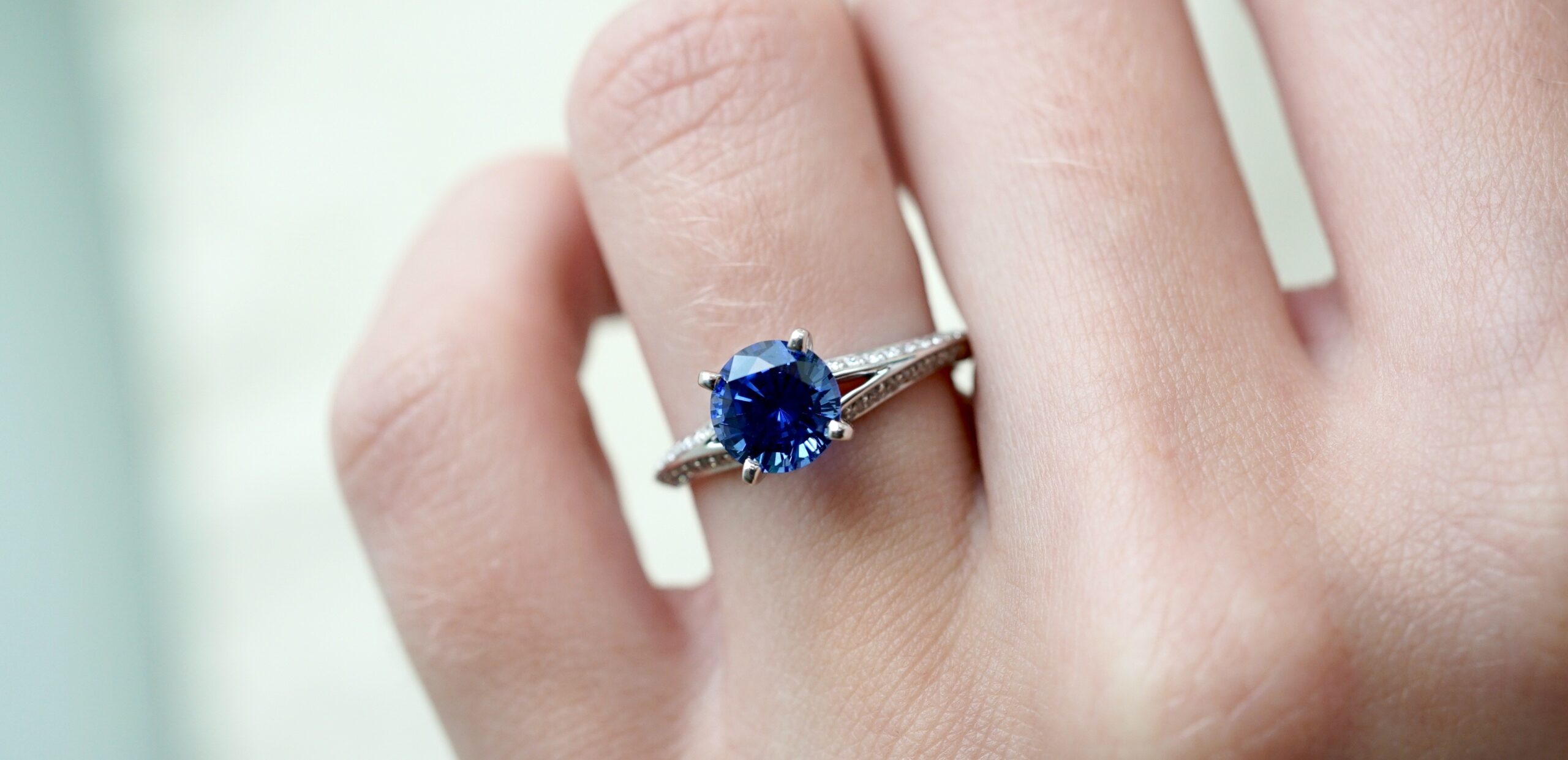
Blue sapphire in Charu
Scientists create Lab sapphire, whereas the earth makes natural sapphire. In addition, natural sapphire comes in more colors and clarities than lab sapphire. For example, lab blue sapphire will always be a pure blue, without tint. On the other hand, natural sapphire can also be greenish blue or violet blue. And lab created sapphires are often flawless, whereas natural sapphires often have microscopic flaws (“inclusions”).
Only a gemologist can tell the difference between high quality lab created sapphire and natural sapphire. Microscopic visual cues a gemologist may use to distinguish lab created sapphire from natural sapphire include locating bubbles, curved striae, or flux inclusions. Flame fusion lab sapphire also glows red under black light.
Gemologists can separate natural sapphire from lab sapphire by finding natural inclusions such as color zoning, fingerprints, or crystal inclusions. However, as natural fingerprints and high quality lab inclusions can often be very difficult to tell apart, a professional is needed! Color can also be used. For example, if the sapphire has a unique tint, odds are it is natural. Lab created sapphire come in pure colors.
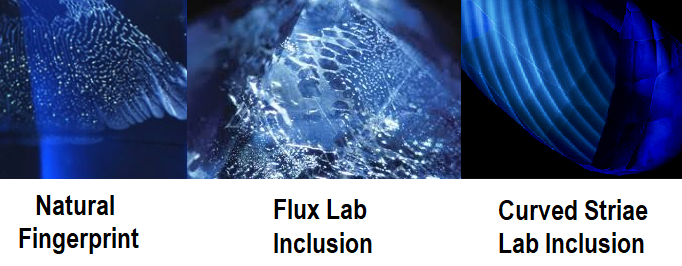
High quality lab created sapphires have a healthy secondary market. Lab sapphire that looks natural retains its value! More and more couples are opting for lab grown sapphire over natural due to their phenomenal sustainability. And, when demand increases, retention of value over time also goes up.
Yes. Natural sapphire is one of the most popular, valuable gemstones on the market. In fact, they are likely the second most popular engagement ring stone. The value of a natural sapphire depends on its color, clarity, carat weight, and treatment. The most valuable natural sapphire will have a medium vivid tone, be eye clean, over two carats, and have only heat treatment. Truly remarkable natural sapphires do not have any heat treatment whatsoever (less than 5% of stones on the market).
Pink-orange “Padparadscha” sapphire is the most rare and expensive variety of sapphire. This is followed by the rich, velvety hues of the more traditional violet blue sapphire. Both of these colors are fairly rare in nature, and their rich colors are highly sought after. And, that demand results in higher value! Because of their popularity, we offer lab grown sapphire in both of these colors, too.
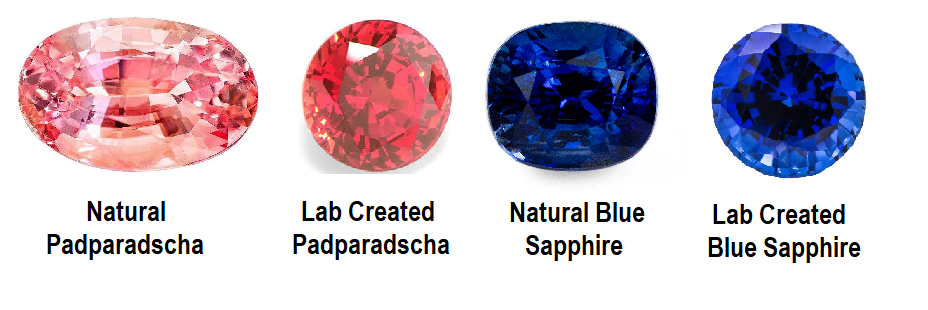
The best quality sapphire is a medium, vivid tone (meaning not too light or too dark), without gray or brown overtone. High quality lab sapphire actually shows perfect sapphire color! So, your lab created stone will be eye clean, bright, and gorgeous. And, if you are looking for a natural sapphire, checking out lab sapphire can actually be a great guide to learn about sapphire color. While that may be surprising, most people looking at natural sapphire make the mistake of looking at overly-dark stones. So, seeing high quality lab sapphire in bright color can be a huge help! Finally, sapphire is a Type II gemstone, which means natural stones usually have some inclusions (though it is possible to find eye clean stones)! Lab created sapphire should appear flawless to the naked eye.
Sapphire is most frequently cut in oval, cushion, and emerald cut shapes. And emerald cut provides the deepest color. However, lab sapphire is able to be cut in any shape you desire! Whatever shape you choose, the most important thing to look for in cut quality is evenness of facets. Sapphire is notorious for being “native cut,” which results in an uneven, lopsided appearance. So, when viewing your sapphire, imagine a dotted line down the center. The sides should be mirror images!
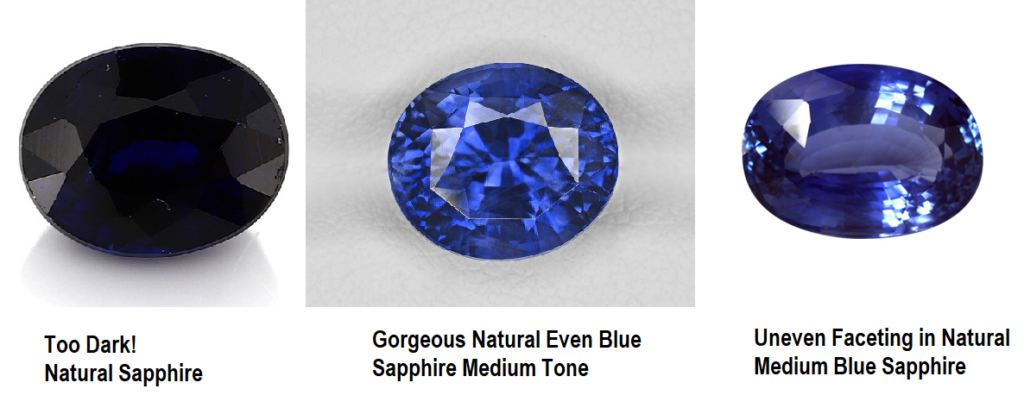
Yes, blue sapphires that are medium or light tone, eye clean, and well cut, sparkle! However, if your stone is too dark, too included, or poorly cut, it will not shine as much. This is because dark stones do not allow for light reflection as much as medium or light tones do. And, cut quality is directly responsible for light reflection and sparkle! So, always make sure your stone is bright enough and well cut! Another thing to remember is that sapphire’s sparkle is different than diamond. So, when you choose a blue sapphire, it will sparkle blue, light blue, and white. On the other hand, diamond (even blue diamonds!) will show rainbow sparkle, too.
Of course! Shoot us an email here, or drop us a note here, and we can work with you to find the perfect stone! Both natural and lab sapphires are gorgeous options. And, there’s a right pick for everyone! We can’t wait to help you build your perfect ring.
Lab Champagne Sapphire in Patronus
You want something different. Something sustainable. And you want it Made in America. If this sounds like you, you may just love Montana Sapphires. Intrigued? Want to know more? Well let’s head to the Rockies!
So what are these Montana Sapphires you keep hearing so much about? Well, Montana Sapphires are – you guessed it – sapphires from Montana. But there’s so much more! Unique colors, high clarity, USA-born status, and great durability make Montana Sapphires shine.
Montana Sapphires are part of the larger gem family “corundum.” Corundum is a hard stone, at a 9 out of 10 on the Mohs scale, making it very durable to wear in jewelry. Although “sapphire” means “blue” (it comes from the Greek word “sapheiros”!), Sapphires are actually the Skittles of the gemstone world. The Sapphire family, corundum, comes in every color of the rainbow, as well as white and black! Gemologists call red corundum “Ruby” and every other color “Sapphire.” While most Montana Sapphires fall within color ranges of blue, green, pink, and yellow, the shades are very different from Sapphires you’ll find in other parts of the world.
Montana Sapphires differ from other Sapphires in color, clarity, treatment, origin, cut, and sustainability.
One of the most striking differences between Montana Sapphires and Sapphires from other areas of the world is their color. Sapphires from Montana are unique in that they naturally occur in light pastels, unique blue-greens, and smoky grays. So, a Montana Sapphire could be a calming bathwater green or a sky blue-grey. This is notable because Sapphires from outside the United States are generally much darker. Yogo Sapphires, found in the Yogo Gulch area of Montana, are celebrated for being bright “cornflower blue” – the most highly sought after Blue Sapphire color in the world.
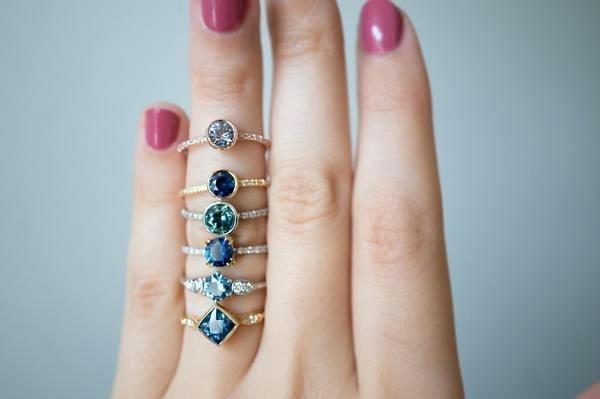
A stack of Montana Sapphire engagement rings. (Photo by: S. Kind & Co)
Montana Sapphires are also unique in their spectacularly high clarity. Sapphire is a “Type 2” gemstone, which means gemologists expect it to have some flaws (or “inclusions.”) Sapphires from Montana, however, are unusually “eye clean,” meaning that most will have no inclusions visible to the naked eye.
Another uncommon feature which separates Montana Sapphires from others is that they are often untreated. Sapphires from other areas of the world are often less eye clean and less beautiful when first mined. In order to correct these less desirable features, gemstone sellers often heat sapphires at incredibly high temperatures. This heat treatment can “heal” some of the stone’s inclusions, and can also make the Sapphire’s color darker and more attractive. However, Montana Sapphires are typically not heated! This makes them unique.
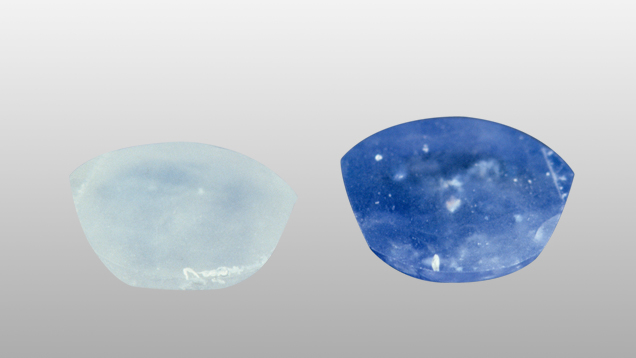
An unheated sapphire on the left, compared to a heated sapphire on the right. (Photo by: GIA)
While most Sapphire mining takes place in Kashmir, Burma, Madagascar, and Sri Lanka, Montana Sapphire is found right here in the good ole’ USA. This is attractive to many couples that want a gem that supports American business. This is attractive to many couples that want a gem that supports American business. In fact, they are not only mined by Americans, but are also typically cut by American gemstone cutters (called “lapidaries”) and sold by American jewelers. This boosts American economy. Purchasing an American mined and cut Sapphire also ensures that the miner who found your gem was paid a fair American wage and was protected by American labor laws. In other words, your Montana Sapphire puts the blue in red, white, and blue.
Speaking of American gemstone cutters, American cut quality is incredible. This is because American lapidaries specialize in custom and machine-cut faceting. Many foreign lapidaries focus on retaining the most carat weight to get the biggest price. American gemstone cutters, on the other hand, more frequently focus on cutting sapphire to get the best color and shape. This means your Montana Sapphire was cut to be its most beautiful self.
Finally, Montana Sapphires differ from other Sapphires in their sustainability. While the mining of foreign Sapphire takes place in traditional ways like tunneling or removal of rock, miners gather Montana Sapphire from streams and dried up creek beds. Experts call this “alluvial” mining. So, because mining in Montana does not require digging up the Earth, it is a much more sustainable natural practice.
Much like choosing a Diamond, couples choose their Sapphire based upon the gemstone’s quality. Choosing a Sapphire, however, is unique in a few ways such as importance of color, gemstone treatment, and seller specialty.
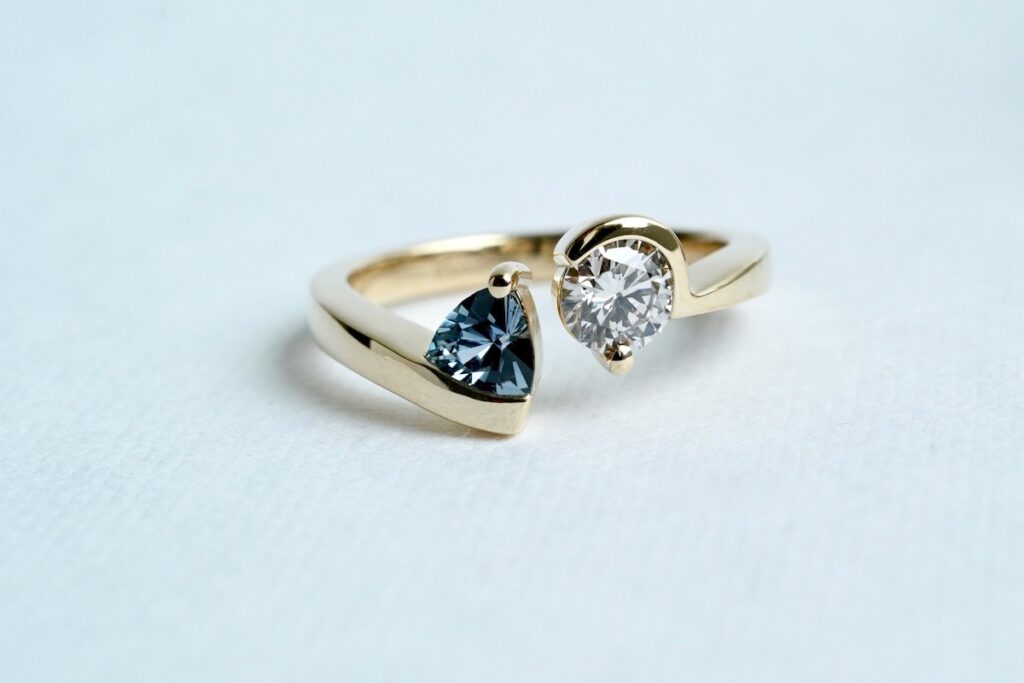
A floating style engagement ring with a .41 carat trillion cut Montana Sapphire.
When choosing a colored stone, such as Sapphire, color is the most important factor. So, picking a stone that is a pleasing, consistent color is your top priority. There are three measures of color, and one bonus requirement:
Choosing a Montana stone is a bit different than selecting a typical, foreign Sapphire. This is because in Montana Sapphire, people love not only cornflower blue, but also greens, lilacs, and other pastels.
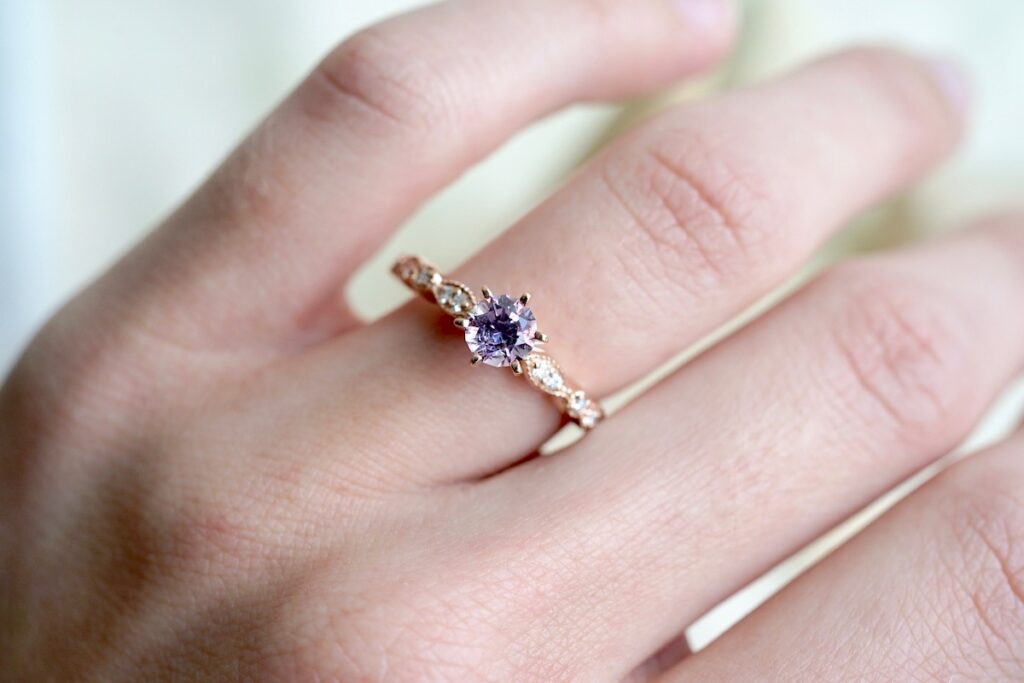
A lilac-colored Montana Sapphire.
The main color of your Sapphire is its “hue.” Hue is determined by the stone’s major color and also any tint the stone may have. So, for example, a stone that is blue without any tint would be graded in hue as simply “Blue.” On the other hand, a stone that is blue with a tint of green would be graded as “greenish-Blue.” Montana Sapphires come in a variety of different hues! People love Yogo Sapphires for being a beautiful cornflower blue (Blue or violetish-Blue). Others may be a striking teal (blueish-Green), a pretty orchid (pinkish-Purple), or any other number of colors!
The “tone” of your Sapphire is how light or dark it is. Gemologists describe tone on a scale beginning with “very light” (almost white) and ending at “very dark” (almost black), with various tones in-between. The most sought after gemstones are medium-toned. This is because medium toned stones show the most color and sparkle.
The “saturation” of your Sapphire is how vivid your stone is. Cool colors, like blue, purple, and green, may show hints of gray. Warm colors, like pink, orange and yellow, may show hints of brown. So, the less brown/gray your stone is, the more “vivid” it is. Imagine saturation as a scale with a full color picture of your gemstone at one end, and a black-and-white or sepia picture at the other. The most sought-after gemstones have “vivid” saturation. Yogo Sapphires are often vividly saturated. Many other Montana Sapphires show low saturation and can be very gray.
Gemologist’s Note: I personally love lowly-saturated (grayish) gemstones. My engagement stone is slightly-grayish (saturation), medium-toned (tone) blueish-Violet (hue)! The moral of the story is “you do you,” because color is very subjective. Pick a stone that speaks to you!
Couples choosing a Montana Sapphire are in luck when it comes to cut. Because Montana gemstones are mostly faceted here in the good ole’ US of A, the quality of faceting is usually spectacular! Ovals, emerald cuts, and cushions are popular shapes. These shapes often also bring out the best color. Because American lapidaries focus on top cutting, you will also regularly find round cuts. Princess, trillion, and heart shapes are more rare. So, pick your favorite shape!
Then, you have to consider light return. Let’s talk about windowing and extinction – don’t choose a gem with too much of either.
Windows are poorly cut sections of a gemstone that leak light instead of reflect it. They are identifiable by picture when a gem shows a lighter-colored, dead area in the center of the stone. In person, one can test for windowing by sweeping a finger beneath the gem. A well cut gemstone will show minimal windowing.
Extinction refers to dark areas in your gem. While some extinction provides a nice light-dark contrast, which keeps your gem lively and interesting to look at, too much extinction makes your stone appear dark, or worse, lop-sided like the far left stone in this photo.
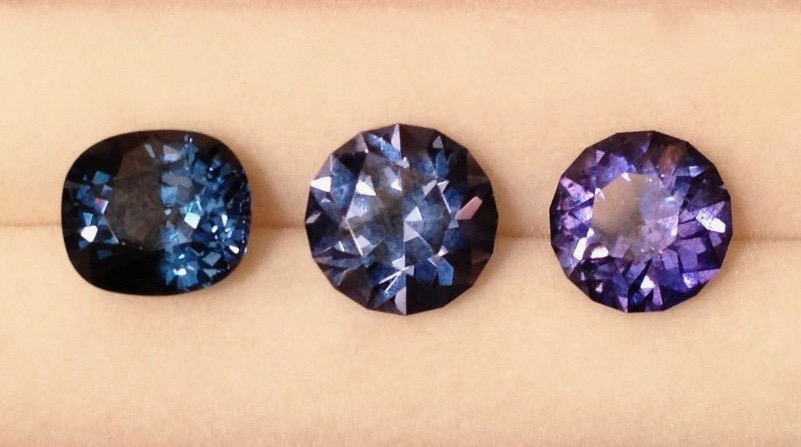
Uneven extinction shown on the left (Photo by: The Gemstone Project).
Sapphires contain natural internal markings called “inclusions.” Unlike Diamonds, Sapphires contain inclusions such as “fingerprints” (partially-healed fractures) and “silk” (minute, crosshatched crystals.) The Sapphire clarity scale ranges from “eye clean” (meaning no inclusions are visible to the naked eye) to “heavily included.” There are various clarity grades in-between. Trade professionals often refer to eye clean gems as “AAA,” meaning the highest quality, and “A” or “B” meaning the lowest quality.
Montana Sapphires are famous for their high clarity grades. So, you should never consider a Montana Sapphire that is not eye clean, or AAA, grade.
Many Montana Sapphires are so beautiful straight out of the ground that they do not require the typical heat treatment that the majority of Sapphire undergoes. Other Montana Sapphires receive heat treatment to improve color. Both heated and no-heat Sapphires are desirable. Some couples prefer “no-heat” stones because of the rarity and mystique. Other couples may prefer the darker, more vivid color of heated gems. No-heat Sapphire commands a higher price than heated Sapphire due to its rarity.
Contrary to popular belief, carat weight does not mean the size of your Sapphire! It only means how heavy it is. Also, it is important to remember that Sapphire is a heavier gemstone than diamond. So, a 2ct. Sapphire will appear smaller in measurement than a 2ct. Diamond. As a result, couples shopping for a Montana Sapphire should always check the measurements of a stone, not just the carat weight.
Pro Tip! Jewelers measure gemstones in millimeters. Grab a ruler and put it on your finger to determine the gemstone size you really want!
Yogo Sapphires (the cornflower blue ones) are very rare in sizes over 0.50ct. So, Yogos are not common engagement ring center stones. Other Montana Sapphires regularly occur in nice large sizes and are perfect engagement stones!
As discussed above, Montana Sapphires are not typically certified like Diamonds are. This can be tricky, especially because country of origin and heat treatment cannot be confirmed visually. So, couples choosing Montana Sapphire should only purchase their stone from a reputable seller, well versed in the distinctions between Montana Sapphires and foreign stones.
Colored Stones, including Sapphire, look best in ring settings with diamond accent. This is because the whiteness of diamonds provides a stunning contrast to the color of the Sapphire center stone. Cool color Sapphires, like blue, violet, and green, look best in cool-colored metals such as white gold, platinum, and palladium. Orange and yellow Sapphires look great in both yellow and white metals, however rose gold should be avoided. Pink and Purple Sapphire looks great in all metals.
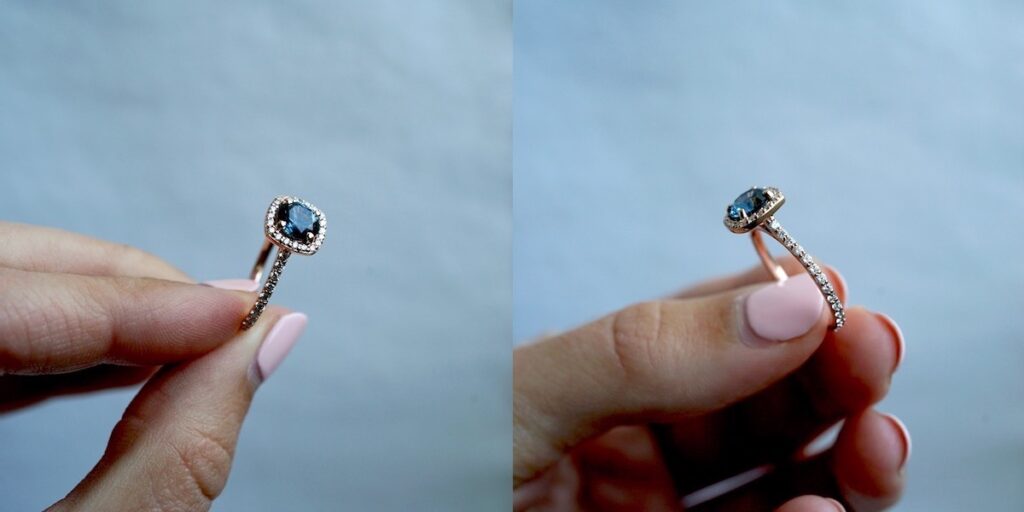
A 6.5mm Montana Sapphire engagement ring with side stones.
I sure can! I love helping couples find just the right stone for them. Send me an email at care@doamore.com, or drop me a note here, and tell me a little about what you’re looking for and I’ll perform a custom search for your perfect Montana Sapphire. Have more questions about Sapphire? Drop me a line!
Platinum has some benefits, but a platinum ring will cost substantially more than a 14k gold ring. Although both metals are priced similarly per gram, a gram of platinum takes up less volume than a gram of gold, so more of it is needed. I also recommend staying away from 18k gold because not only is it more expensive than 14k gold, it is also softer and can be scratched more easily. 14k white gold or palladium are the better options when looking for affordable engagement rings! Read more about Gold vs Platinum.
Although I go over tips on selecting an affordable diamond below, they are still one of the most expensive options for a center stone. If you are on a budget, other options can make a ring more affordable, yet just as beautiful. Two of these options are moissanite and sapphire.
Moissanite was originally discovered in a meteor, and is an extremely rare mineral. That’s why moissanite, as we know it in jewelry, is exclusively lab created. The main advantage of moissanite is that it is very similar in look to a diamond (some actually prefer the look over diamonds), but costs a lot less. The below table compares the stones in pricing:
| Diamond Carat Weight | GIA Certified Round Diamond (I-color, VS2) | Moissanite | Forever-Brilliant Moissanite |
| 0.5 | $1,000+ | $90 | $180 |
| 1.0 | $4,000+ | $270 | $400 |
| 1.5 | $10,000+ | $450 | $700 |
Our post on Diamonds vs Moissanite compares the two stones in more depth, and also discusses Forever Brilliant Moissanite. All of these engagement rings are available with moissanite center stones.
Sapphire is a natural, precious stone and is one of the most sought after centerstones. Typically thought of as blue, sapphires are actually available in all the colors of the rainbow. Even excellent quality sapphires (AAA rating) can offer substantial savings over a diamond.
| Diamond Carat Weight | GIA Certified Round Diamond (I-color, VS2) | Round Blue Sapphire (Natural, AAA) | Round Pink Sapphire (Natural, AAA) |
| 0.5 | $1,000+ | $840 | $780 |
| 1.0 | $4,000+ | $2,000 | $1,800 |
| 1.5 | $10,000+ | $3,300 | $2,700 |
As you can see, natural sapphires can offer significant savings over a diamond. Other gemstones, such aquamarine and rubies, are even less costly than sapphires. All of these engagement rings are available with any gemstone, including sapphire, aquamarine, and topaz.
When looking for affordable engagement rings, a large part of the savings will come when choosing the center stone. If you elect for a diamond, then there are several criteria you should consider when using our diamond search tool:
A GIA-certified diamond will have a color rating that typically ranges from D (colorless) to K (faint yellow). If you are on a budget, it would be wise to stay out of the colorless range (D-F). The price difference between a colorless diamond and a near colorless diamond can be substantial. If you want a diamond that appears colorless, then I would recommend a G color diamond, but if you are okay with a diamond that has a very slight tinge of yellow, then I recommend an I color diamond.

Diamonds tend to decrease in price as you go from the left to the right (colorless to faint). When looking for affordable engagement rings, stay out of the colorless range.
A GIA-certified diamond will have a clarity rating that ranges from F (flawless) to I (included). Clarity refers to how many imperfections a diamond has, and a flawless diamond means there are no imperfections. A diamond with a VS2 clarity rating has very few imperfections, but they can’t be seen with the naked eye. SI1 rated diamonds’ imperfections can technically be seen with the naked eye, but most everyday people wouldn’t be able to find them. For people on a budget, I recommend purchasing a diamond starting in the SI1 or SI2 range. If you are okay with some minor imperfections that can be seen with the naked eye upon close examination, then an I1 could be a great possibility as well.

People on a budget should consider a slightly included diamond (SI1 or SI2), or even a higher-rated included diamond (I1).
GIA-certified round diamonds have cut ratings that range from poor to excellent. A diamond’s cut is what gives a diamond its brilliance, or sparkle. Because most yearn for a diamond with sparkle, this is one of the most important criteria when considering a diamond. A poorly cut diamond does not optimally reflect light, and will therefore appear more dull and less brilliant than a well cut diamond. It is wise to pick the best cut diamond you can find within your budget, and when looking for affordable engagement rings, it is usually worth sacrificing a color or clarity rating if it gets you a better cut. Because cut is slightly complicated, please feel free to contact us when picking a diamond and we would be more than happy to advise you.
An engagement ring is a once-in-a-lifetime purchase, but that doesn’t mean it can’t be affordable. We love to help customers who are looking for affordable engagement rings because many times the options are even more beautiful and unique than a pricier ring. If you have questions when looking for affordable engagement rings, please contact us and we will give you the best advice we can on making one of your most special purchases ever, an economical one! Feel free to ask for me (Krish) personally, because customers’ on a budget are one of my favorite customers to work with!
CONTACT US FOR ASSISTANCE WITH FINDING SOMETHING IN YOUR BUDGET>